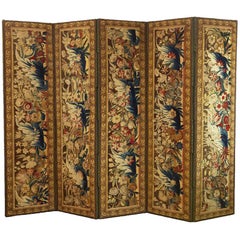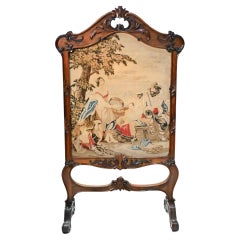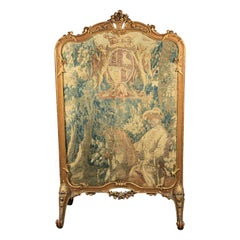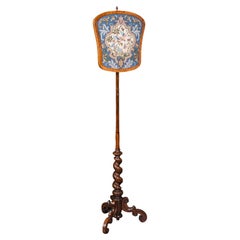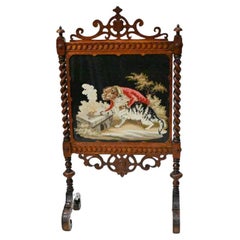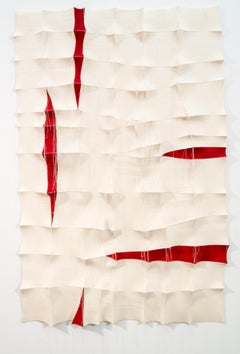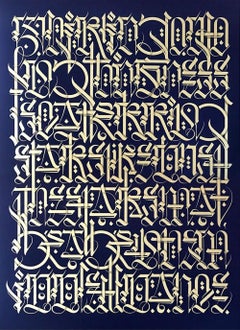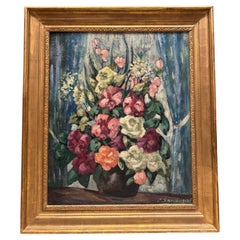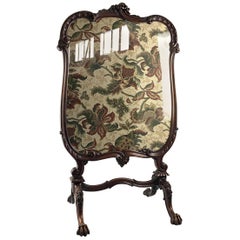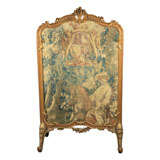A Tapestry Screen
Antique Late 17th Century Belgian Screens and Room Dividers
Tapestry
Antique 1840s Victorian Tapestries
Mahogany
Antique 18th Century and Earlier French Screens and Room Dividers
Wool, Tapestry, Wood
Antique Early 19th Century British Screens and Room Dividers
Wood
Antique 1890s Victorian Picture Frames
Mahogany
2010s Contemporary Abstract Sculptures
Felt, Thread, Mixed Media, Screen
2010s Street Art Prints and Multiples
Gold, Gold Leaf
Early 20th Century French Art Deco Paintings
Canvas
Recent Sales
Antique 19th Century English Screens and Room Dividers
Tapestry
Antique 18th Century and Earlier French Fireplace Tools and Chimney Pots
Wool, Tapestry
Vintage 1950s French Tapestries
Linen
Antique 1840s Victorian Paintings and Screens
Mahogany
Mid-20th Century French Mid-Century Modern Tapestries
Wool
Early 20th Century English Screens and Room Dividers
Textile, Tapestry
Antique 18th Century and Earlier Screens and Room Dividers
Antique Late 18th Century French Side Tables
Tapestry, Walnut
2010s Contemporary Abstract Sculptures
Felt, Thread, Mixed Media, Screen
2010s Contemporary Abstract Sculptures
Felt, Thread, Mixed Media, Screen
2010s Contemporary Abstract Sculptures
Felt, Thread, Mixed Media, Screen
2010s Contemporary Abstract Sculptures
Felt, Thread, Mixed Media, Screen
20th Century Tapestries
Fabric
Antique Late 19th Century French Aubusson Tapestries
Wool
Antique 19th Century English Regency Screens and Room Dividers
Rosewood
Antique Early 19th Century French Rococo Screens and Room Dividers
Antique 19th Century English Georgian Fireplace Tools and Chimney Pots
Mahogany, Tapestry
1980s Op Art Abstract Prints
Screen
1960s Expressionist Abstract Prints
Screen, Cotton Canvas
Antique 19th Century Screens and Room Dividers
20th Century French Fireplace Tools and Chimney Pots
Wood, Fabric, Textile
Antique 19th Century French Screens and Room Dividers
Textile
People Also Browsed
2010s Austrian Jugendstil Wall Lights and Sconces
Brass
21st Century and Contemporary Italian Art Deco Wall Lights and Sconces
Brass
Antique Late 19th Century French Louis XV Table Mirrors
Bronze
Antique Late 19th Century English Neoclassical Revival Musical Instruments
Bronze
Antique Late 19th Century French Louis XIV Armchairs
Upholstery, Velvet, Walnut
Vintage 1980s American Organic Modern Club Chairs
Rattan, Hardwood, Cane
Vintage 1960s Italian Mid-Century Modern Console Tables
Bamboo, Wicker, Rattan
Antique Late 19th Century American Renaissance Revival Architectural Ele...
Pottery
Vintage 1940s European Art Deco Chandeliers and Pendants
Murano Glass
Mid-20th Century Industrial Benches
Aluminum
Antique 18th Century Swedish Rococo Commodes and Chests of Drawers
Wood
Antique Early 19th Century British Screens and Room Dividers
Wood
Vintage 1940s Italian Art Nouveau Table Lamps
Brass
Mid-20th Century French Art Deco Patio and Garden Furniture
Stone, Wrought Iron
Vintage 1940s French Neoclassical Coffee and Cocktail Tables
Brass
Late 20th Century French Art Deco Screens and Room Dividers
Wood
A Tapestry Screen For Sale on 1stDibs
How Much is an A Tapestry Screen?
- What is a tapestry?1 Answer1stDibs ExpertFebruary 22, 2021A tapestry is a piece of hanging textile art that contains pictures or designs. A tapestry is created by weaving colored weft threads or by embroidering directly onto canvas.
- Can you frame a tapestry?1 Answer1stDibs ExpertFebruary 22, 2021You can frame a tapestry using a tapestry frame, which works to keep the canvas taut and hang the item. There are many different types of tapestry frames, though a popular one has a top wooden clamp with a hanging mechanism and a bottom wooden clamp to weigh down the material.
- What is a tapestry used for?1 Answer1stDibs ExpertFebruary 22, 2021Tapestries is a decorative piece of heavy fabric that's usually hand-woven. It can be used as wall art, to cover furniture, or as an area rug.
- Where did tapestry originate?1 Answer1stDibs ExpertFebruary 13, 2024Historians are not completely sure where tapestries originated. Ancient literature from Rome, Greece and other civilizations does not specifically mention tapestries, but that doesn't mean that they didn't exist. We do know that the Ancient Egyptians did produce and utilize tapestries, as examples have been discovered in the tombs of Thutmose IV and Tutankhamen. The word tapestry wasn't coined until the 15th century, and it originated in England. Find a wide variety of tapestries on 1stDibs.
- What is embroidered tapestry?1 Answer1stDibs ExpertApril 5, 2022Tapestries are thick, textile art that’s often hung from the wall as a method of displaying it. Embroidery is a type of needlework that uses counted threads and stitches to create patterns or images. An embroidered tapestry is a fabric wall hanging that features the art of embroidery for visual impact. On 1stDibs, find a variety of original artwork from top artists.
- What is Flemish tapestry?1 Answer1stDibs ExpertApril 5, 2022A Flemish tapestry is a decorative woven wall hanging produced in Flanders, primarily during the 15th, 16th and 17th centuries. Peter Paul Rubens and Bernard van Orley are two of the most famous Flemish artists to work in the medium. You'll find a variety of Flemish tapestries on 1stDibs.
- Where can I buy tapestries?3 Answers1stDibs ExpertFebruary 22, 2021You can buy tapestries on 1stDibs.com. 1stDibs has a variety of different tapestries in different colors, patterns, and prices.
 Antique Textiles GalleriesFebruary 25, 2021Most of our textiles, tapestries, furnishings and pillows are available through 1stdibs. A.T.G.H.C’s beautifully crafted and hand sewn work exhibits our creative eye for detail in made-to-order luxury throw pillows and furnishings with the exceptional textiles of our vast collection.
Antique Textiles GalleriesFebruary 25, 2021Most of our textiles, tapestries, furnishings and pillows are available through 1stdibs. A.T.G.H.C’s beautifully crafted and hand sewn work exhibits our creative eye for detail in made-to-order luxury throw pillows and furnishings with the exceptional textiles of our vast collection. NazmiyalMarch 23, 2021You can find many of our Tapestries on the 1st dibs platform.
NazmiyalMarch 23, 2021You can find many of our Tapestries on the 1st dibs platform. - What do tapestries symbolize?1 Answer1stDibs ExpertMay 14, 2024What tapestries symbolize is largely a matter of individual interpretation. Because early examples graced the walls of palaces and grand estates, many people associate them with wealth, royalty, power and prestige. Individual tapestries may symbolize different themes based on the images and symbols that they display. For example, art historians believe the medieval Lady and the Unicorn tapestries represent the five human senses: sight, hearing, taste, touch and smell. On 1stDibs, shop a selection of tapestries.
- What are tapestries made of?1 Answer1stDibs ExpertFebruary 27, 2024Tapestries are made out of a wide range of materials. Wool is arguably the most commonly used to produce the threads for weaving tapestries. In some cases, silk or metallic threads will be mixed in with wool for added luster. Some weavers opt for other materials, such as cellulose and cotton. Find a selection of tapestries on 1stDibs.
- How are tapestries made?1 Answer1stDibs ExpertSeptember 25, 2019
Tapestries are handwoven on a loom is such a way that only the weft (horizontal) threads are visible.
- What is a Chinese screen?1 Answer
 Lotus GallerySeptember 23, 2020
Lotus GallerySeptember 23, 2020A Chinese screen can refer to a number or things, including standing folding room dividers, architectural window or door screen panels, or even decorative latticework hangings.
- 1stDibs ExpertApril 5, 2022To know if a tapestry is valuable, seek the help of a licensed appraiser. Because condition has a big impact on what a tapestry is worth, you will need an expert to thoroughly inspect the textile. On 1stDibs, find a range of expertly vetted tapestries.
- 1stDibs ExpertApril 5, 2022By definition, tapestries are woven textiles, not embroidered fabrics. However, you will sometimes see people refer to embroidered wall hangings as tapestries because both types of decorative textiles function as wall décor. On 1stDibs, shop a large collection of tapestries.
- How are Coromandel screens made?1 Answer1stDibs ExpertApril 5, 2022Coromandel screens were made with a technique used in the 16th and 17th centuries, where large panels of wood were primed with ash, lacquer compound and even pig’s blood. You’ll find a variety of Coromandel screens from some of the world’s top sellers on 1stDibs.
- 1stDibs ExpertAugust 17, 2021Japanese screens are called Byōbu and are made from many panels with beautiful calligraphy and paintings. These folding screens can be a decorative and interesting way to separate rooms in a living space. Find a collection of Japanese screens for sale on 1stDibs.
- 1stDibs ExpertSeptember 28, 2021A dressing screen is a translucent folding screen that typically acts as a room divider to provide privacy and diffuse light throughout the room. They are often called room dividers or folding screens. On 1stDibs, find a collection of antique, new and vintage dressing screens.
- 1stDibs ExpertSeptember 25, 2019
Screen printing (or serigraphy) involves forcing ink onto a surface through a screen made of fine material to form a picture or pattern.
- 1stDibs ExpertNovember 2, 2021A fire screen is often called a fireguard. It's a protective screen that is positioned in front of a fireplace in order to keep flames and hot embers from flying into the room. On 1stDibs, find a variety of antique and vintage fire screens, fire tools and chimney pots.
- 1stDibs ExpertApril 5, 2022Japanese screen painting is the art of creating byōbu, or Japanese screens. Byōbu vary in subject matter and style. The screens are free-standing, portable and decorated with symbolic images or calligraphy. It is common to find byōbu in pairs with at least two panels. Shop a selection of byōbu on 1stDibs.
- 1stDibs ExpertApril 5, 2022A Chinese Coromandel screen is a folding piece of furniture produced in China by artisans working with a certain material. Specifically, the screens are Coromandel, a hardwood that features black and brown stripes. The screens often function as room dividers, but some people display them purely for decorative purposes. On 1stDibs, find a collection of Coromandel screens.
